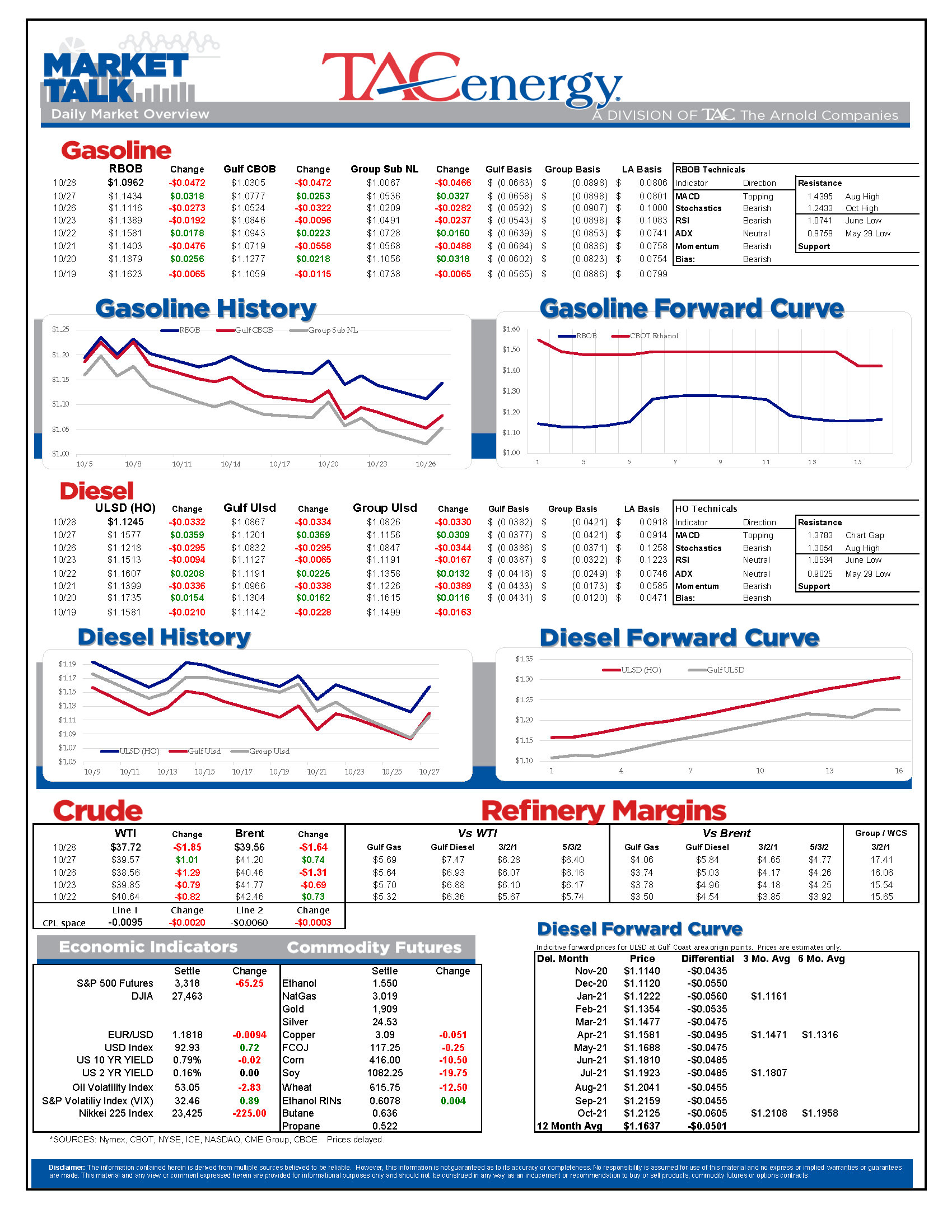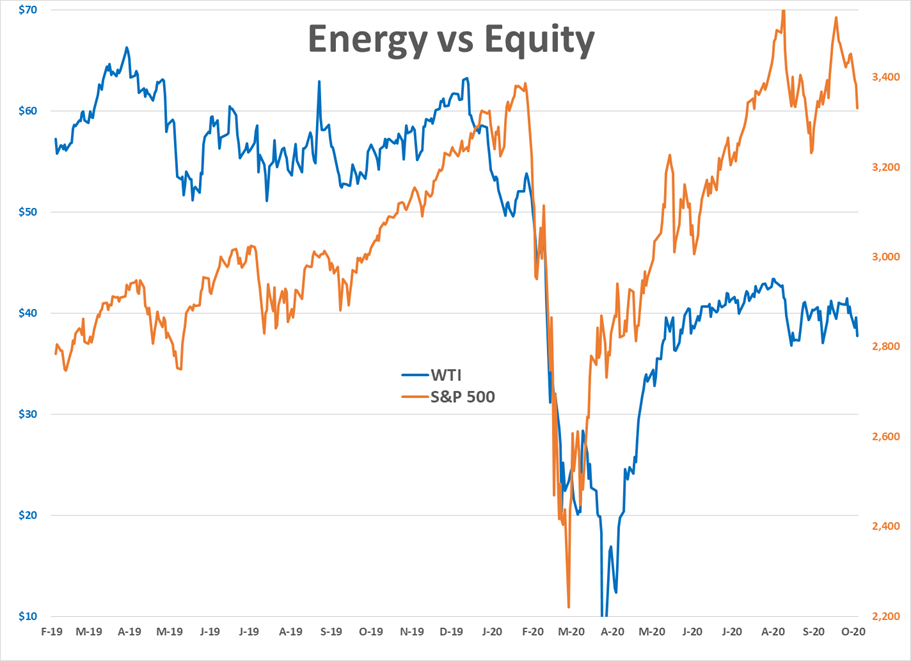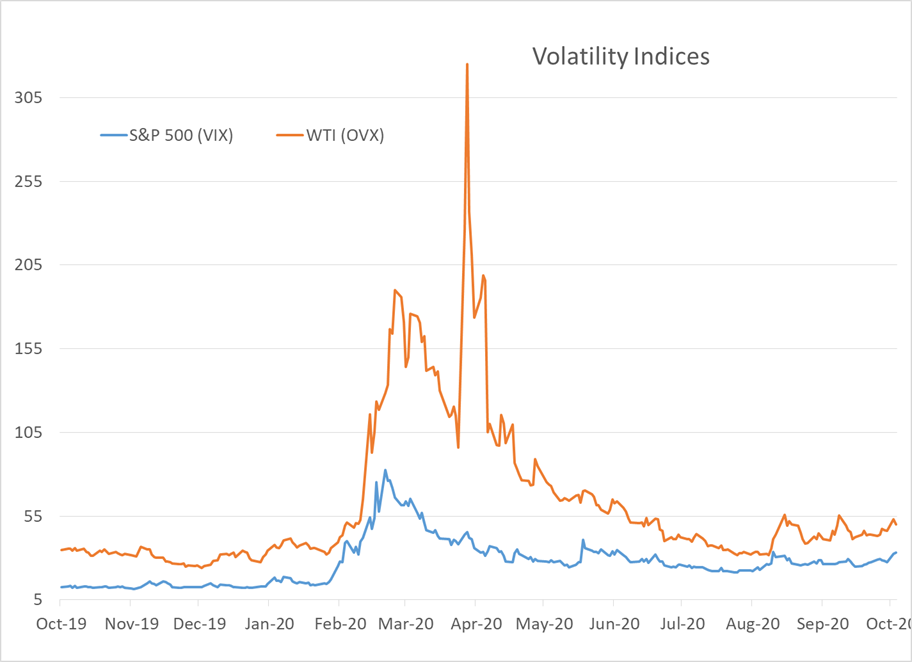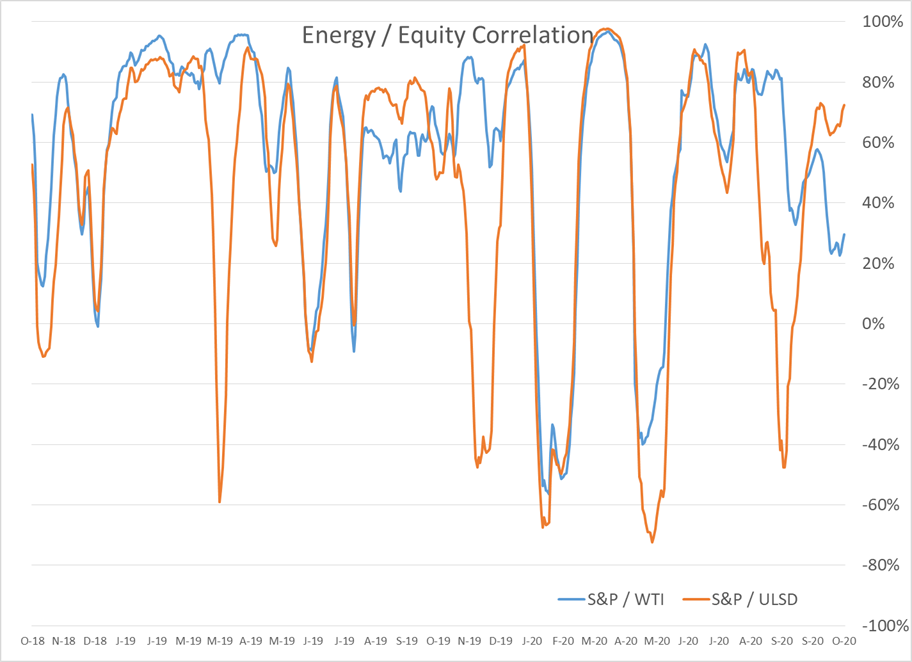Volatility Creeps Higher

It’s a risk off type of day as another heavy wave of selling grips energy and equity markets around the world, pushing oil and gasoline prices to fresh three week lows after a solid recovery bounce in Tuesday’s session. Volatility is creeping higher after staying relatively subdued throughout most of the summer and fall, and many are suggesting that political turmoil could keep contributing to larger daily swings over the next couple of weeks.
Large builds in crude oil and gasoline inventories (4.6 million and 2.3 million barrels respectively) reported by the API are taking credit for the early wave of selling that’s wiping out Tuesday’s gains, while an even larger decline in diesel inventories of 5.3 million barrels appears to be largely ignored. Even more telling of the pessimism early on, nearly 9% of the country’s refining capacity looks to be within 50 miles of a Category 2 hurricane as it hits land this evening, and yet refined products are down 3-4%.
Hurricane Zeta now appears that it will likely reach Category 2 status with winds approaching 100 mph before hitting the coast this evening, but it is moving forward at a high rate of speed, so the rainfall totals are looking less impressive than what we see from slower moving storms, which will hopefully keep flooding in the region to lower levels.
It looks like New Orleans luck may have finally run out during this record-setting hurricane season as Zeta has stayed on course to pass near the city this evening. That puts the P66 Alliance refinery, Valero Meraux and PBF Chalmette facilities less than 10 miles from the eye of the storm as it moves over what passes for land along the Mississippi River Delta. Meanwhile, the Norco and Garyville refineries will be within 20-50 miles based on the current path. Alliance was reported to stay closed after Sally for maintenance and due to weak economics, and the other facilities are all running below capacity due to weak demand. A Reuters report Tuesday suggested the facilities will continue to operate through the storm, and so far no contrary reports have been released. Roughly half of Gulf of Mexico oil production has been shut in as a precaution.
The Colonial and Plantation pipeline operations are north and west of where the storm is projected to make landfall, so it seems like a low risk that supply further upstream will be directly impacted, which means markets along the southeast aren’t likely to see any disruption in fuel supplies. The other good news from the fast forward movement of this storm is it will only take a day to move through the Southeastern U.S., minimizing its negative impacts on fuel demand as well.
Spot gasoline prices in the group 3 market are now flirting with the $1/gallon mark, and based on the way the charts and seasonal demand patterns are setting up, it’s starting to seem inevitable that we’ll see that level broken in the near future, and that other regions may soon follow suit if RBOB futures can break below the June lows near $1.07, which is just a couple cents away from current levels.
Click here to download a PDF of today's TACenergy Market Talk.
Latest Posts
Week 16 - US DOE Inventory Recap
Energy Markets Trading Quietly In The Red As Ethanol Prices Rally To Five-Month High
The Struggle For Renewable Producers Continues As A Rapid Influx Of Supply And Crashing Credit Prices Make Biodiesel
After Years Of Backwardation, Diesel Prices Have Slipped Into Contango Over The Past Week
Social Media
News & Views
View All
Week 16 - US DOE Inventory Recap

Energy Markets Trading Quietly In The Red As Ethanol Prices Rally To Five-Month High
Energy markets are trading quietly in the red to start Wednesday’s session after a healthy bounce Tuesday afternoon suggested the Israel-Iran-linked liquidation had finally run its course.
There are reports of more Ukrainian strikes on Russian energy assets overnight, but the sources are sketchy so far, and the market doesn’t seem to be reacting as if this is legitimate news.
Ethanol prices have rallied to a 5-month high this week as corn and other grain prices have rallied after the latest crop progress update highlighted risks to farmers this year, lower grain export expectations from Ukraine, and the approval of E15 blends this summer despite the fact it pollutes more. The rally in grain and renewables prices has also helped RIN values find a bid after it looked like they were about to test their 4-year lows last week.
The API reported small changes in refined product inventories last week, with gasoline stocks down about 600,000, while distillates were up 724,000. Crude oil inventories increased by 3.2 million barrels according to the industry-group estimates. The DOE’s weekly report is due out at its normal time this morning.
Total reported another upset at its Port Arthur refinery that’s been a frequent flier on the TCEQ alerts since the January deep freeze knocked it offline and damaged multiple operating units. This latest upset seems minor as the un-named unit impacted was returned to normal operations in under an hour. Gulf Coast basis markets have shrugged off most reports of refinery upsets this year as the region remains well supplied, and it’s unlikely we’ll see any impact from this news.
California conversely reacted in a big way to reports of an upset at Chevron’s El Segundo refinery outside of LA, with CARBOB basis values jumping by more than a dime. Energy News Today continued to show its value by reporting the upset before the flaring notice was even reported to area regulators, proving once again it’s ahead of the curve on refinery-related events. Another industry news outlet meanwhile struggled just to remember where the country’s largest diesel seller is located.
Click here to download a PDF of today's TACenergy Market Talk

The Struggle For Renewable Producers Continues As A Rapid Influx Of Supply And Crashing Credit Prices Make Biodiesel
The sigh of relief selloff continues in energy markets Tuesday morning, with gasoline prices now down more than 20 cents in 7 sessions, while diesel prices have dropped 26 cents in the past 12. Crude oil prices are within a few pennies of reaching a 1 month low as a lack of headlines from the world’s hot spots allows some reflection into the state of the world’s spare capacity for both oil and refined products.
Gasoline prices are trading near a 6-week low this morning, but still need to fall about another nickel in order to break the weekly trendline that pushed prices steadily higher since December. If that trend breaks, it will be safer to say that we saw the end of the spring gasoline rally on April 12th for the 2nd year in a row. Last year RBOB futures peaked on April 12 at $2.8943 and bottomed out on May 4th at $2.2500. The high (at this point) for this year was set on April 12th at $2.8516, and the low overnight was $2.6454.
It’s not just energy commodities that are seeing an unwind of the “flight to safety” trade: Gold prices had their biggest selloff in 2 years Monday and continue to point lower today. Just how much money poured into commodities in the weeks leading up to the direct confrontation between Israel and Iran is unclear, but we have seen in year’s past that these unwind-events can create a snowball effect as traders can be forced to sell to cover their margin calls.
Supply > Demand: The EIA this morning highlighted the record setting demand for natural gas in the US last year, which was not nearly enough to offset the glut of supply that forced prices to a record low in February. A shortage of natural gas in Europe was a key driver of the chaotic markets that smashed just about every record in 2022, and an excess of natural gas supply in Europe and the US this year is acting as a buffer, particularly on diesel prices.
The struggle for renewable producers continues as a rapid influx of supply and crashing credit prices make Biodiesel, RD and SAF unprofitable for many. In addition to the plant closures announced in the past 6 months, Vertex Energy reported Monday it’s operating its Renewable Diesel facility in Mobile AL at just 50% of capacity in Q1. The truly scary part for many is that the $1/gallon Blender's tax credit ends this year and is being replaced by the “Clean” Fuel production credit that forces producers to prove their emissions reductions in order to qualify for an increased subsidy. It’s impossible to say at this point how much the net reduction will be for domestic producers, but importers will get nothing, and at current CI values, many biodiesel producers may see their “blend credit” cut by more than half.
Click here to download a PDF of today's TACenergy Market Talk.





